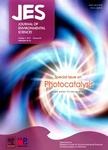Particulate matter pollution in Kunshan High-Tech zone: Source apportionment with trace elements, plume evolution and its monitoring
Particulate matter pollution in Kunshan High-Tech zone: Source apportionment with trace elements,plume evolution and its monitoring作者机构:Jiangsu Skyray Instrument Co. Ltd. Kunshan 215300 China ARIA Technologies SABoulogne-Billancourt 92100 France Kunshan Environment Monitoring Station Kunshan 215300 China State Environmental Protection Key Laboratory of Urban Ambient Air Particulate Matter Pollution Prevention and ControlCollege of Environmental Science and Engineering Nankai University Tianjin 300000 China Center for Urban Transport Emission Research College of Environmental Science and Engineering Nankai University Tianjin 300000 China Ecole Nationale Superieure des Mines de Douai Douai France Kinton Environmental Technology Co. Ltd. Nanjing 210000 China Chengdu University of Information Science and Technology Chengdu 610000 China Hohai Uniuersity Nanjing 210000 China
出 版 物:《Journal of Environmental Sciences》 (环境科学学报(英文版))
年 卷 期:2018年第30卷第9期
页 面:119-126页
核心收录:
学科分类:0830[工学-环境科学与工程(可授工学、理学、农学学位)] 07[理学] 070602[理学-大气物理学与大气环境] 0706[理学-大气科学]
基 金:supported by the Ministry of Science and Technology of China under grant number 2014DFG92630 by BPIFrance of France under grant number A1305005Z
主 题:Particulate matter pollution Trace elements Online pollution monitoring in a industrial zone Source apportionment Plume evolution
摘 要:Particulate matter (PM} in the Kunshan High-Tech zone is studied during a three-month campaign. PM and trace elements are measured by the online pollution monitoring, forecast-warning and source term retrieval system AS3. Hourly measured concentrations of PM10, PM2.5 and 16 trace elements in the PM2.5 section (Ca, Pb, Cu, C1, V, Cr, Fe, Ti, Mn, Ni, Zn, Ga, As, Se, Sr, Ba) are focused. Source apportionment of trace elements by Positive Matrix Factorization modeling indicates that there are five major sources, including dust, industrial processing, traffic, combustion, and sea salt with contribution rate of 23.68%, 21.66%, 14.30%, 22.03%, and 6.89%, respectively. Prediction ofptume dispersion from concrete plant and traffic emissions shows that PM20 pollution of concrete plant is three orders of magnitude more than that of the traffic. The influence range can extend to more than 3 km in 1 hr. Because the footprint of the industrial plumes is constantly moving according to the local meteorological conditions, the fixed monitoring sites scattered in a few hundred meters haven't captured the heaviest pollution plume at the local scale of a few km2. As a more intensive monitoring network is not operationally possible, the use of online modeling gives accurate and quantitative information of plume location, which increases the spatial pollution monitoring capacity and improves the understanding of measurement data. These results indicate that the development of the AS3 system, which combines monitoring equipment and air pollution modeling systems, is beneficial to the real-time pollution monitoring in the industrial zone.



